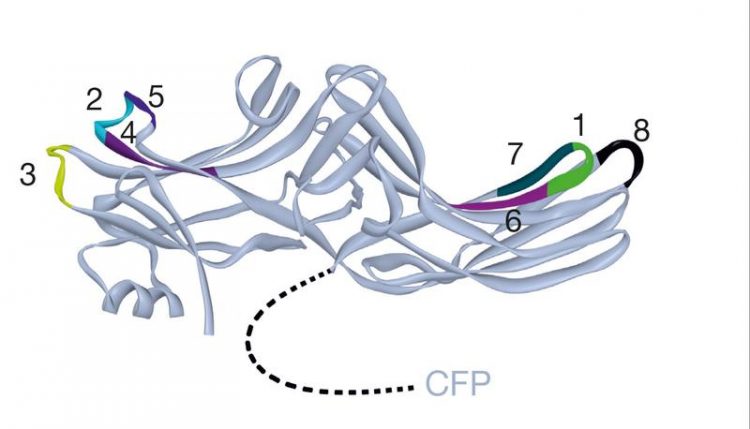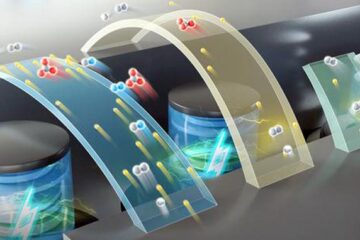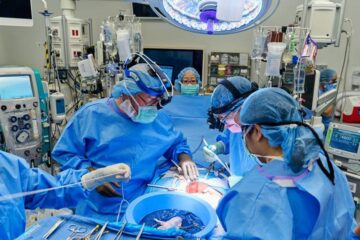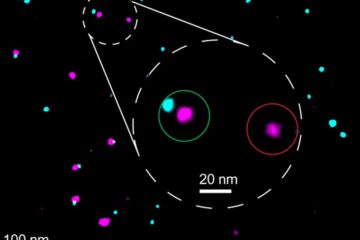Researchers identified an important signaling molecule of cell communication

Schematic drawing of β(beta)Arrestin2. With these biosensors (colored), scientists were able to study spatial movements of the protein in real time in living cells. Group Hoffmann, Rudolf Virchow Center
International scientists led by Carsten Hoffmann and Martin Lohse of the University Würzburg, Germany, identified for the first timeβ-Arrestin as an independent signaling molecule. The protein modulates a pharmaceutically important pathway. The results were published in the prestigious scientific journal “Nature”. It leads to new drug targets, for example in pain therapy.
The most important target for drug research are G-protein coupled receptors (GPCR). Around 30 percent of all medicine work on more than 800 members of this class of proteins. GPCRs are crucial for cell communication and the processing of pain and sensory stimuli.
The protein β-Arrestin regulates GPCR. However, it remained unclear how it functions on a molecular level. With biosensors, scientists were able to explain the interaction on a temporal and spatial level. “When I discovered β-Arrestin in 1990, it looked like, it is there to disable receptors,” said Lohse. “That it acts as an independent signaling molecule, we could demonstrate only now with the latest technology.”
Experiments showed that β-Arrestin was transferred into an active state by receptors, which lasted longer that its interaction with the receptor. The change was so significant that a cycle of activation and deactivation of β-Arrestin was detectable – a criterion for the definition of an independent signaling molecule. At the same time, American collaborators were able to show that the type of activation of β-Arrestin depends on the activating receptor.
Their results will be also published in “Nature”. The exchange with American colleagues pushed the project enormously. Hoffmann became aware of their work during a conference. “This project went through ups and downs,” Hoffmann remembers. “We often had to be patient, but it was worth it.”
By molecular reinforcing or blocking of β-Arrestin, the effect of future drugs could be more specific and associated with fewer side effects. Due to their diversity, GPCR and now possibly β-Arrestin are important targets for pharmaceutical substances. Hoffmann expects a particularly good progress in long-term treatment with strong painkillers.
The body gets used to the medicine and becomes increasingly depended on higher doses. At the same time, side effect will appear even stronger. New medicine targeting specifically β-Arrestin on a molecular level could minimize this tolerance and therefore its side effects, and could enable a more effective long-term therapy.
Hoffmann is optimistic about future projects. As a next step, he wants to test whether activation of β-Arrestin can be changed by model substances. “That would be the first step to new medical drugs.”
Publication: Susanne Nuber, Ulrike Zabel, Kristina Lorenz, Andreas Nuber, Graeme Milligan, Andrew B. Tobin, Martin J. Lohse, Carsten Hoffmann β-Arrestin biosensors reveal a rapid, receptor-dependent activation/deactivation cycle. Nature doi:10.1038/nature17198
Person:
Prof Carsten Hoffmann joined the Rudolf Virchow Center for Experimental Biomedicine of the University of Würzburg in 2012.
Prof Martin Lohse is founder and chair of the Rudolf Virchow Center and future scientific manager and chairman of the Max Delbück Center for Molecular Medicine (MDC) in Berlin.
Research group Hoffmann:
http://www.rudolf-virchow-zentrum.de/forschung/arbeitsgruppen/ag-hoffmann/forsch…
Research group Lohse:
http://www.rudolf-virchow-zentrum.de/forschung/arbeitsgruppen/ag-lohse/forschung…
The Rudolf Virchow Center for Experimental Biomedicine is a central institution of the University of Würzburg. Research groups are working on target proteins, which are essential for cellular function and therefore central to health and disease.
Contact
Prof. Dr. Carsten Hoffmann
Tel. 0049 (0)931 3148304, c.hoffmann@toxi.uni-wuerzburg.de
Prof. Dr. Martin Lohse
Tel. 0049 (0)931 3148400, lohse@toxi.uni-wuerzburg.de
Dr. Daniela Diefenbacher (Press Office, Rudolf Virchow Center)
Tel. 0049 (0)931 3188631, daniela.diefenbacher@uni-wuerzburg.de
http://www.rudolf-virchow-zentrum.de/en/news/news/article/forscher-entschluessel…
Media Contact
All latest news from the category: Life Sciences and Chemistry
Articles and reports from the Life Sciences and chemistry area deal with applied and basic research into modern biology, chemistry and human medicine.
Valuable information can be found on a range of life sciences fields including bacteriology, biochemistry, bionics, bioinformatics, biophysics, biotechnology, genetics, geobotany, human biology, marine biology, microbiology, molecular biology, cellular biology, zoology, bioinorganic chemistry, microchemistry and environmental chemistry.
Newest articles

High-energy-density aqueous battery based on halogen multi-electron transfer
Traditional non-aqueous lithium-ion batteries have a high energy density, but their safety is compromised due to the flammable organic electrolytes they utilize. Aqueous batteries use water as the solvent for…

First-ever combined heart pump and pig kidney transplant
…gives new hope to patient with terminal illness. Surgeons at NYU Langone Health performed the first-ever combined mechanical heart pump and gene-edited pig kidney transplant surgery in a 54-year-old woman…

Biophysics: Testing how well biomarkers work
LMU researchers have developed a method to determine how reliably target proteins can be labeled using super-resolution fluorescence microscopy. Modern microscopy techniques make it possible to examine the inner workings…





















